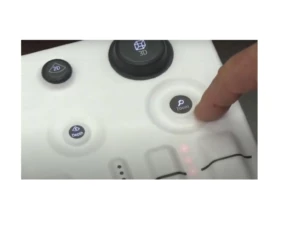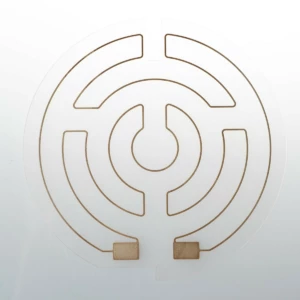The Future is Here With In-Mold Electronics
 Imagine creating products that offer consumers increased simplicity, enhanced performance and jaw-dropping beauty – and doing so with cheaper production costs and less waste – making it more environmentally friendly.
Imagine creating products that offer consumers increased simplicity, enhanced performance and jaw-dropping beauty – and doing so with cheaper production costs and less waste – making it more environmentally friendly.
Not possible, you say? Think again. Think: “In-mold electronics (IME),” a promising technology that has numerous industries beginning to sit up and take notice.
While IME has been around for a little while, it’s still relatively new to many OEMs, designers and engineers. So, we decided to ask two DuraTech IME experts, Steve Roellich, Printed Electronics Development Engineer, and Paul Hatlem, Sales Manager, exactly what this technology is and why you’re going to want it for next generation product development.
What is IME and how can it be used?
Paul: In-mold electronics is an exciting technology that combines screen printing functional inks and injection molding. It has all of the benefits of in-mold decorating (IMD) with the addition of printed, conductive inks – creating a unique solution for user experiences.
Steve: Essentially, IME embeds electronic circuits between layers of plastic to protect them from the environment, reduce product weight and size while improving reliability. If you’re developing products that require:
- 3D or flat user interface surfaces to reduce weight and/or minimize space requirements
- No cracks and crevices around switches or buttons where dirt and bacteria can hide
- Market differentiation
- Thin heating elements such as LED headlights or defrosting
- “Solid State” replacements for membrane switches
- A maximum amount of weather resistance, then IME is for you.
How is IME different from IMD/IML?
Steve: Unlike in-mold decorating or in-mold labeling (IMD/IML), which applies only to graphics, IME allows for the addition of electronic circuit inks to an IMD label or a stand-alone circuit. IME also includes an electrically functional component such as human-machine interface (HMI), sensors, or heaters.
What are IME’s benefits?
Paul: IME allows a lot of creative freedom. For example, you can take a flat part and transform it into three dimensions. Take a washing machine backsplash: It’s basically all flat because every button, every light, every dial is connected to a printed circuit board directly behind it, which is flat; there’s no changing that. With IME, you can design a 3D, “curvaceous” shape – indents for the buttons, for example – without worrying about connecting to a flat circuit board.
In many cases, IME offers a lower-cost alternative to traditional technologies, as it requires fewer raw materials, less assembly and manufacturing steps. It’s extremely reliable as there are no moving parts; and produces less waste, making the manufacturing process more environmentally friendly. We’re also looking at whether we can connect to in-molded circuits without an actual, physical connection. In other words, can we pass electrical signals through the air into that IME piece? Think about a stove top backsplash. If you’re like me – I’m a messy cook – I’m splattering stuff all over. Without physical electrical connections, you could literally pop that backsplash off, put it in the dishwasher and then pop it back on. Talk about a kitchen wonder!
Steve: The fact that there’s real estate inside a plastic part to encapsulate circuits, sensors and other components allows you to eliminate wires, reduce a product’s bulk and significantly reduce exposure failures. An analogy I sometimes use is when you look at a room, you see lots of space – both used and unused from a volume standpoint. If you install shelves, you’re now using space that was already there. You can think about IME the same way. There’s a certain amount of volume in plastic that’s currently unused. You can put electronics in there without compromising the part’s integrity. Now you have a smart piece of plastic. Whether you use it to illuminate, eliminate buttons for user interface or leverage it for marketing real estate – you streamline the efficiency of the design and reduce the overall volume of materials. That’s the point of IME.
Who uses IME?
Paul: Because of its design freedom and ability to still meet functional needs, IME today is becoming more widely used by user interface manufacturers; driven largely by automotive (pun intended!) and closely followed by home appliances and consumer electronics. And, because IME lends itself to compact, lighter weight products, the growth potential in medical device is enormous.
Steve: What’s more, because plastic parts and electronics are used in just about every industry, the sky’s the limit: Automotive – of course. Medical device? Absolutely. Appliances? Yes. OEM, you bet. A racquetball paddle? Why not? A frisbee golf disk? We can encapsulate IME there, too. If an industry uses plastic parts and electronics, IME can lend itself to it.
What are DuraTech IME capabilities?

Steve: We focus on human machine interface (HMI), which is what most people see featured in IME marketing materials. However, a product could just carry an electrical signal, without capacitive touch; a smart surface that’s illuminated, for example. Another prime example is the heaters we make. They’re IME, but they’re basic. We print the electronics, place it in an injection molding tool to form a lens for a snowplow. There’s no user interface or HMI, but it’s the biggest IME in the world by far. We sell hundreds of thousands of them.
Paul: As far as we know, there are only two companies in the world that are mass producing IME parts, DuraTech being one of them. A lot of companies are demonstrating IME, but they don’t have the capability to put it into high volume production. Steve always has an eye on production intent, believing that it’s great to build a beautiful looking prototype, but if it takes all handwork to produce the product, you’re never going to get production quantity at a reasonable price.
I’d be remiss if I didn’t also mention our reputation for taking on challenging projects such as IME (as well as screen printing multiple colors on difficult substrates with unique features and finishing techniques). Our customer service team and project managers really get involved in this work. Everyone here has a can-do attitude. We see IME as a challenge. Customers come to us saying, “Well, you made this happen, so you must be able to make that happen!”
What must a customer know about IME to successfully partner with DuraTech?
Steve: Right now, IME is new and exciting tech. However, because it’ still new, IME comes with development time that can stretch a customer’s patience and risk tolerance. For the best possible outcome, we recommend that a customer brings us on in the beginning of the project and design for manufacture based on guidelines we supply. Of course, we love to conduct experiments for customers with hard designs, but they end up costing money and time. Yes, the experiments always yield results, but sometimes the result is that it doesn’t work. Bottom line, if you’re going to use IME, you have to design for that unique manufacturing process.
Paul: It’s important to understand that every part is unique. It’s difficult to take an existing injection molded part and make it an IME part – the injection mold tooling will probably have to change. It’s better to start at ground zero, with the design, and work with DuraTech on what’s possible and what’s not. The first iterations can take a couple of months. While it can be difficult to allow for that much time, ultimately, you’ll end up with a really high quality part with great functionality.
What qualities should a customer look for in an IME partner?
Steve: Look for a printer that has an open mind. One that has an R&D function is even better, as is a printer that has strong relationships with molders who are also willing to step outside their comfort zones. Good technical salespeople who can effectively show parts are critical, too.
Paul: What Steve said. Plus, you want a printer that has some experience in IME mass production as opposed to someone whose experience is limited to prototypes only.
Our experts continually expand their knowledge of emerging printed electronics technology and can assist you on-site with adapting your in-mold electronics (IME), also known as in-mold structural electronics (IMSE®), drawings or prototypes for mass production.
Head to our YouTube to see IME in action.